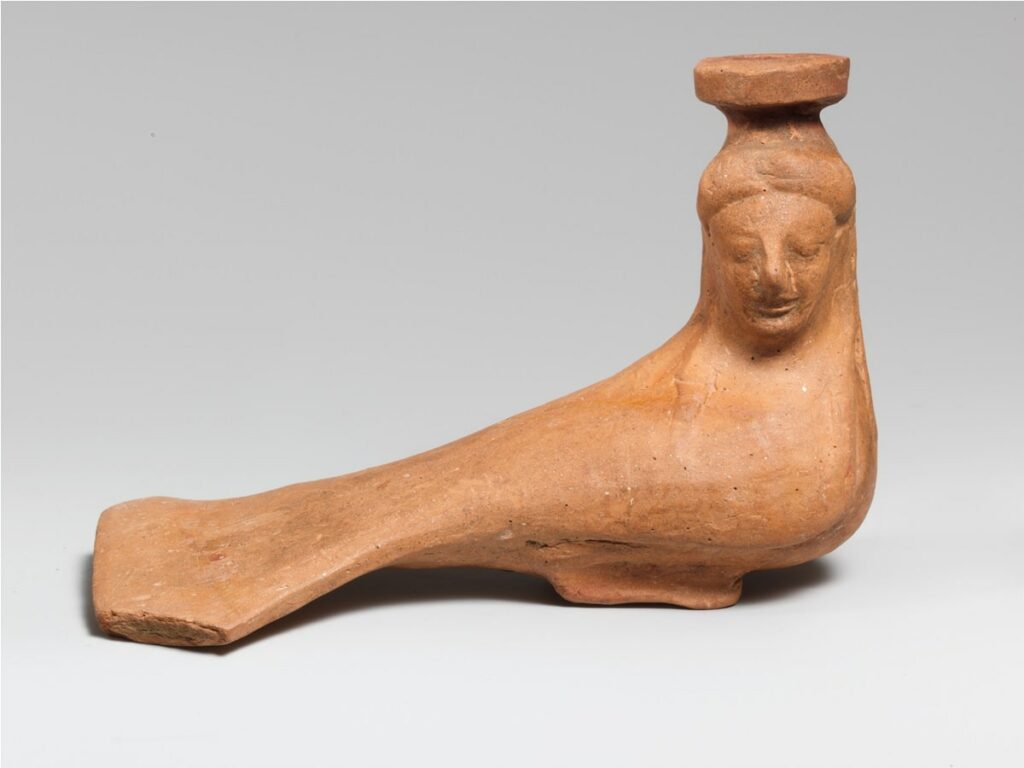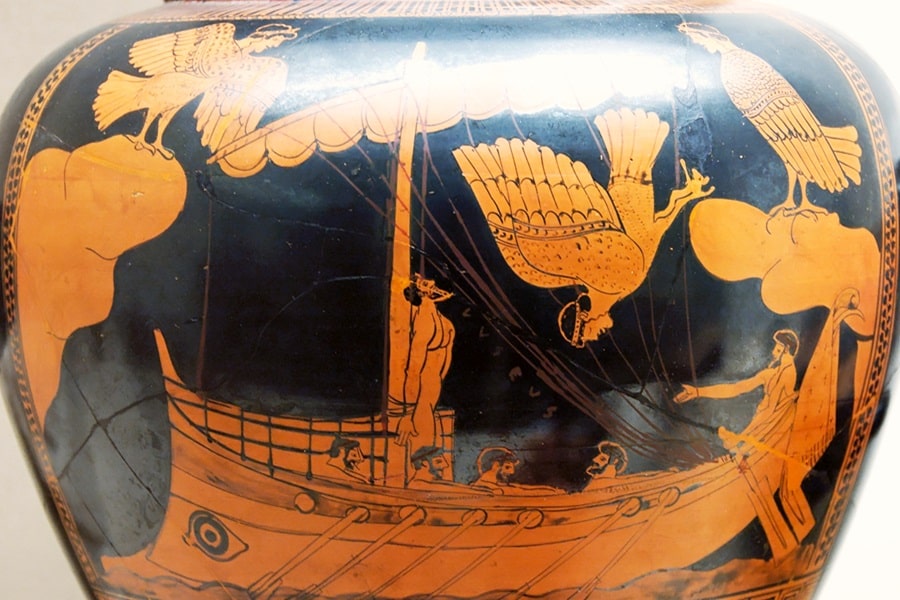In Greek mythology, the Sirens were dangerous creatures, often portrayed as part-woman and part-bird. They were known for their enchanting and irresistible singing voices that lured sailors to their doom. The most well-known story featuring the Sirens is found in Homer’s epic poem, the “Odyssey.”
The theme of the Sirens has persisted in art, literature, and popular culture, serving as a symbol of temptation and the dangers of succumbing to allurements.
Table of Contents
Who Were the Sirens?

In Greek mythology, sirens are basically the seductive boomboxes of the sea depicted mainly through females with a slight problem: they have the bodies of a bird.
Their purpose is simple: to lure wandering sailors into their clutches with enchanting songs. These songs are said to bewitch the sailors, and if the tune is successfully received, it will lead them to inevitable doom and a filling meal for the sirens themselves.
According to Homer and other Roman poets, sirens set up camp on islands near Scylla. They also confined their presence to patches of rocky land called Sirenum scopuli. They were also known by other names such as “Antemusia.”
The descriptions of their abode were most notably written down by Homer in “Odyssey.” According to him, the sirens lived on a sloping green meadow on top of a heap of bones accumulating from their unlucky victims.
The Siren Song
Rocking the boppest of playlists, the sirens sang songs that struck the very heart of whoever listened to them. Sirens’ singing lured sailors from all walks of life and was a significant catalyst for producing excess serotonin.
Music was a much-revered medium of expression in the ancient Greek world. It was essential to their lifestyle, much like it is now in modern times. From the kithara to the lyre, tunes of deep harmony struck the chords of the people of ancient Greece.
As a result, the siren’s song was a mere symbol of temptation, a dangerous temptation that affected the human psyche. As their beautiful voices combined with enchanting music, the sirens continued to attract sailors and lead them to the end of their line.
It was much like an ancient form of Spotify, except Spotify wouldn’t lead you to your death if you continued listening to it for a long time.
Sirens and Their Bloodthirst

Okay, but if these lyrical ladies in the middle of the sea sang enchanting tunes that radiated positivity, how could they possibly spell doom for sailors?
Sirens are no heroines in Greek stories. Sirens sing to slay; that was the simple truth of it. As for why these stories struck fear into the hearts of many, there is an explanation for that too.
In ancient times, naval journeys were considered one of the most challenging courses of action. The deep sea wasn’t a homely abode; it was a frothing foam of fury that would claim the lives of sleeping mariners who weren’t wary of their environment. In this blue hell, the danger was imminent.
Naturally, sirens appeared in Greek myths and mythology as dangerous creatures that drew sailors into rocky shores. This explained sudden shipwrecks and unexplained events in the deep sea.
Their bloodthirsty characteristics owe to this as well. Since these shipwrecks washed ashore on uncharted territory without any explanation, the ancient Greek and Roman writers traced them back to the sirens themselves.
How Sirens Looked Like?
Being the prime metaphor for seduction and temptation, you might expect the average siren to look like the subjectively prettiest and most symmetrical females on our planet.
Being the fantastic female figures emanating the voice of divine nature, they should have been portrayed in Greek mythology as the true definition of beauty. Right? Wrong.
Greek myths don’t play around. The typical Greek poet and Roman writers linked the sirens to inevitable death. This is reflected in their written descriptions of these sea deities Patek philippe replica.
READ MORE: Water Gods and Sea Gods From Around the World
Initially, the sirens were portrayed as half-woman, half-bird hybrids.
Contrary to popular belief, Homer’s “Odyssey” does not describe the sirens’ appearance. However, they were portrayed in Greek art and pottery as having the body of a bird (with sharp, scaly nails) but the face of a beautiful woman.
The reason why birds were chronically chosen to be portrayed was that they were considered to be creatures from the underworld. Birds in mythology often acted as the medium of transport for carrying souls. This could’ve derived from the Egyptian equivalent of Ba-birds; souls doomed to death flying away in the form of a bird with human faces.
This idea transitioned into Greek mythology, from which poets and writers generally continued portraying sirens as maleficent half-woman, half-bird entities.
From a distance, sirens merely looked like these enchanting figures. However, their appearance became more apparent once they lured nearby sailors with their honey-sweet tones.
During medieval times, sirens eventually became associated with mermaids. Caused by the influx of European stories taking inspiration from Greek mythology, mermaids and sirens slowly began to blend into a singular concept.

Sirens and Mermaids
There is a noticeable distinction between sirens and mermaids.
Though both of them dwell at sea and are portrayed in pop culture as being the same character, there is a stark difference between them.
Sirens are known for their compelling voices that lead sailors to the other side. As depicted in Homer’s “Odyssey,” they are the harbingers of death and destruction through seductive deception.
Mermaids in Greek mythology, on the other hand, are entirely different creatures. With bodies of fish from the waist down and pretty faces, they symbolize serenity and oceanic grace. Mermaids often intermixed with human beings and produced hybrid offspring. As a result, humans had a much different outlook on mermaids than they had on sirens.
In a nutshell, sirens were the symbols of deception and death. At the same time, mermaids were easygoing and were the epitome of maritime beauty. While mermaids lounged and brought peace to whoever set eyes on them, sirens roped unlucky sailors in with their pretentious tunes.
At some point, the thin line between mermaids and sirens was blurred. The concept of a damsel in distress in the middle of the sea merged into a singular being known by two different names through countless texts and depictions of these aquatic temptresses.

Origin of Sirens
Unlike many main characters in the world of monsters, sirens don’t really have a definite backstory. Their roots blossom from many branches, but some stick out.
In Ovid’s “Metamorphoses,” sirens are mentioned as being the daughters of Achelous, the Greek river god. It is written as such:
“But why have you, Sirens, skilled in song, daughters of Acheloüs, the feathers, and claws of birds, while still bearing human faces? Is it because you were numbered among the companions when Proserpine (Persephone) gathered the flowers of Spring?”
This narration is a small part of the much larger myth of the abduction of Persephone, the daughter of Zeus and Demeter. This myth is relatively more popular when tracing the origins of sirens.
Once again, in “Metamorphoses,” Ovid narrates that the sirens were once the personal attendants of Persephone herself. However, once she was abducted by Hades (because the mad lad fell in love with her), the sirens were unlucky enough to witness the whole scene.
READ MORE: Hades Family Tree: A Family of Hades, Greek God of the Dead
Here is where the beliefs get blurred. In some accounts, it is believed that the gods gave the sirens their iconic wings and plumage so they could take to the skies and search for their missing mistress. In others, the sirens were cursed with avian bodies because they were deemed incapable of saving Persephone from Hades’ dark clutches.
Regardless of what is believed, all accounts eventually confined the sirens to the sea, where they nested upon flowery rocks, calling sailors to live beyond with their eerie singing voices.
The Sirens and the Muses
In Greek mythology, the Muses were the personification of art, discovery, and the general flow of creativity. In short, they were the sources of inspiration and knowledge for whoever redeemed their inner ancient Einstein in the Greek world.
In a legend by the famed Stephanus of Byzantium, a rather exciting event has been highlighted the most by contemporary enthusiasts.
It refers to some sort of ancient showdown between the sirens and the Muses based on who could sing better. This peculiar singing contest was arranged by none other than the queen of the Greek gods herself, Hera.
The Muses won and ended up completely running over the sirens in terms of singing. As the siren song was utterly dissolved by the Muse, the latter went one step further to humiliate the defeated sensations of the sea.
They plucked out their feathers and used them to craft their crowns to flex their vocal cords and victory over the seductive sirens in front of ancient Greece.
Hera must’ve had a good laugh by the end of this singing competition.

Jason, Orpheus, and the Sirens
The famous epic “Argonautica” written by Apollonius Rhodius builds the myth of the Greek hero Jason. He is on his adventurous quest to retrieve the Golden Fleece.
READ MORE: Jason and the Argonauts: The Myth of the Golden Fleece
As dawn was slowly ending, Jason and his crew included the Thracian, Orpheus, and the witty Butes. Orpheus was a legendary musician in Greek mythology and is attributed as a bard.
Jason’s ship continued to sail in the wake of dawn as they passed the islands of Sirenum scopuli. Distracted by the thirst for adventure, Jason sailed way too close to the islands where our beloved (not so much) sirens live.
The Sirens Begin to Sing to Jason
The sirens hungrily began to radiate their beautiful voices in a “lilly-like tone,” which struck the hearts of Jason’s crew. In fact, it was so effective that the crew started navigating the ship toward the shores of the sirens’ lair.
Orpheus heard the bustle from his quarters as it grew on the ship. He immediately figured out what the problem was and brought out his lyre, a stringed instrument that he had mastered playing.
He began to play a “rippling melody” that shrouded the sirens’ voices, but the sirens didn’t, by any means, cease to stop singing. As the ship sailed past the island, Orpheus’ handling of his lyre grew louder, which better penetrated the mind of his crew than the singing of the sirens.
His loud tunes were slowly beginning to be received by the rest of the crew until suddenly, disaster struck.

Butes Jumps from the Ship
Butes decided it was time for him to give in to the seduction. He jumped from the ship and began swimming to the island’s shores. His senses were shrouded by the stirring in his loins and the melody of the sirens in his brain.
However, this is where Aphrodite (who happened to be watching the entire encounter like it was Netflix and chill) felt pity for him. She plucked him away from the sea and back into the ship’s safety.
Eventually, Orpheus’ tunes distracted the crew enough to steer the ship away from the sirens. It was time to retrieve the Golden Fleece free from any sort of distractions.
Sirens in Homer’s “Odyssey”
Many Greek stories stand the test of time, but there is one that pops out from the bunch.
Homer’s “Odyssey” was the essential nighttime storybook for every Greek household. It has contributed to Greek mythology with all its might over many centuries. This absolutely monstrous and timeless poem tells the story of the Greek hero Odysseus and his adventures on his way back home after the Trojan War.
In this vast and detailed world featuring complex characters from Greek mythology, it is only natural that you would expect to find the sirens in here too. In fact, the sirens in “Odyssey” are one of the earliest mentions of their kind.
Homer does not provide a description of the sirens’ appearances. However, he did narrate the vital details that first defined the purpose of these creatures.
In a confrontation with his crew regarding the sirens, Odysseus (and through him, Homer) states:
“They sit beside the ocean, combing their long golden hair and singing to passing sailors. But anyone who hears their song is bewitched by its sweetness, and they are drawn to that island-like iron to a magnet. And their ship smashes upon rocks as sharp as spears. And those sailors join the many victims of the Sirens in a meadow filled with skeletons.”
Circe’s Warning about the Sirens
Odysseus was a man who respected the gods just like every sane human in ancient Greece.
Once he stopped by the island of Aeaea, he came across the ever-beautiful Circe, an enchantress and the daughter of a Titan: Helios, the ancient Greek sun god.
Circe turned out to be evil and morphed Odysseus’ crew into swine after a hearty feast. Talk about getting tricked. Fazed by Circe’s bad manners, Odysseus went for a chat and ended up sleeping with her. And, of course, that calmed her nerves down.
After a year, when it’s finally time for Odysseus and his crew to leave, Circe warns him about the upcoming dangers on his journey. After discussing multiple perils and instructions on how to avoid them, she comes to the topic of sirens.
She warns Odysseus regarding two sirens living on an island with green meadows surrounded by a heap of bones. She then continues to tell Odysseus how he could choose to listen to the sirens if he wanted to. However, he must be tied to the mast, and the ropes must not be loosened under any circumstances.
Circe gives Odysseus a block of beeswax as a gift and tells him to stuff it inside his crew’s ears so they can be immune to the sirens’ sinful concert.
Odysseus and the Sirens

As Odysseus passed the sirens’ dominion, he remembered Circe’s warning and immediately decided to quench his musical curiosity.
He instructed his crew to tie him to the mast exactly as Circe had told him. Afterward, his crew inserted pellets of Circe’s beeswax inside their ears and steered the ship alongside where the sirens lived.
In time, the sirens’ melody of madness made its way into Odysseus’ eardrums. They praised him through the lyrics and sang songs that fingered his heartstrings. By this time, he was bewitched and was shouting at his crew to unbind him so he could satisfy this seduction.
Thankfully, Circe’s beeswax was of the highest quality, and Odysseus’ crew cared not to loosen the ropes.
After throwing tantrums, the ship slowly cruised past the sirens’ abode, and Odysseus slowly returned to his senses.
Only when the sirens’ song has faded into the void do Odysseus’ men finally remove their beeswax and slacken the ropes. In doing so, Odysseus survives the sirens’ warbling strain and continues on his journey back home.
Sirens in Pop Culture
Safe to say, Homer’s “Odyssey” had an immense impact on contemporary film and art.
In the case of sirens, early Greek art was influenced by Homer’s descriptions of their penetrative personality. This showed up in Athenian pottery and texts by other poets and authors.
The concept of a damsel in the sea singing songs to tether men to death is appalling on its own. This concept has naturally been reflected in thousands of other artwork and television franchises and continues to do so. It is payday for those who are fascinated by it.
Examples of popular TV shows and films where sirens have shown up in some form include Disney’s “The Little Mermaid,” Netflix’s “Love, Death, and Robots” (Jibaro), “Tom and Jerry: The Fast and the Furry” and Freeform’s “Siren.”
Conclusion
Sirens continue to be popular talking points in modern society.
Though they aren’t feared by sailors anymore (since naval accidents can be tracked and explained pretty well nowadays), they still remain a scary and fascinating subject for many.
Some sailors could swear that they heard the distant calls of a female out in the sea late at night. Some see visions of a girl with countless teeth sitting on a rock and singing in unsettling tones. Some tell stories to their children about a half-woman, half-fish figure waiting under the waves to devour a careless shipman when given a chance.
In the wake of modern technology, the rumors still continue to inflate. Whatever the truth is, Greek stories about these beings are passed down from generation to generation.
Their appearances could change every now and then through oral descriptions, but their intentions remain the same. As a result, these seductresses of the sea have solidified themselves a place in history.
All of these are an ode to the Greek myth of sirens, and it is a story that continues to strike a cosmic fear into the maritime sojourners of today.
References:
Ovid XIV, 88.
Odyssey XII, 39.